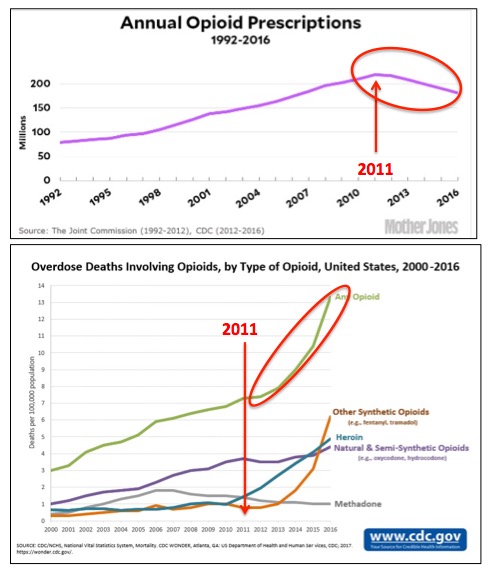Earlier this year I wrote about how our misguided and foolish "policies" to control drugs of abuse were simply backfiring and causing more damage to opioid users (and abusers). Any fan of Breaking Bad will know that efforts to curb the conversion of Sudafed (pseudoephedrine) to methamphetamine by putting it behind pharmacy counters and requiring photo ID not only inconvenienced allergy sufferers but also enticed former "meth cookers" to come up with a better way to make methamphetamine (See Dear CDC: What Will You Screw Up Next? Meth Is Back).
And they did just that. A new CNN report demonstrates just how successful we were in promoting a more efficient organic synthesis of methamphetamine. Meth is back and it's better, cheaper, and more plentiful than ever. And it's pouring in from Mexico.
One of the states being hardest is Oklahoma. Captain Mark Wollmershauser Jr. of the Tulsa Police Department discussed the difference between what the city experienced in 2011 and what is happening now. During that time people were making meth using the "shake and bake" method in garages, and (not surprisingly) there were routinely explosions and fires (1). Wollmershauser explained:
"People were not just burning themselves while cooking meth but were causing damage to other residents that had nothing to do with methamphetamine...[i]t was a really horrible time."
Capt. Mark Wollmershauser Jr., Tulsa Police Department
But things have changed. Now, instead of a whole bunch of seriously nasty chemicals which give a low yield (2) of an impure mess, methamphetamine can be made cleanly, safely, and in large quantities in a one-step reaction, which is called the P2P method (3).

The P2P method of methamphetamine synthesis. Clean, efficient, and easy.
Not surprisingly, prices on the street are far lower- $1100 per ounce in 2012 compared with $250-450 now.
"That's as cheap as I have ever seen methamphetamine my entire career."
DEA agent Richard Salter
So, that restriction of a useful decongestant sure worked well, right? Actually, no it didn't (Figure 1).

Figure 1. Following the elimination of most "home-grown" meth labs, overdoses in Oklahoma more than doubled, from 140 in 2012 to 327 in 2017. Source: Oklahoma Office of the Chief Medical Examiner, Graphic: Will Houp, CNN
If this graph looks familiar, perhaps it's because of the following:
Figure 2. During the five-year period when opioid prescriptions were decreased by about 25% the death rate from all opioids doubled. Why? Because both addicts and pain patients were forced to seek out street drugs instead, meaning fentanyl - the real killer.
And for anyone who has been watching the bungling of the "opioid crisis," (a good deal of it due to government interference), the following cannot be a surprise. Because you already know that when government tries to "solve" one drug problem another one, almost always worse, will pop up to replace it. But Mark Woodward, a spokesperson for Oklahoma Bureau of Narcotics sure knows this:
There's so much attention -- not just in Oklahoma, but nationwide -- on the opioid crisis. But our single most deadly individual drug is methamphetamine.
Mark Woodward, Oklahoma Bureau of Narcotics.
So, here we go again:
- Government perceives a problem with a drug of abuse
- Government plots a course of action.
- History tells us that this course of action will fail spectacularly.
- Government doesn't read history books.
- The course of action fails spectacularly.
- People suffer and die.
- See #1.
I don't really know what else to say.
NOTES:
(1) To any chemist, it must seem astonishing that anyone could use the "shake and bake" method and not blow themselves up. Some of the chemicals involved are ammonium nitrate (blew up an entire city in Texas), lithium metal (bursts into flames and explodes when exposed to water), concentrated sodium hydroxide (Drano), and flammable solvents, such as methyl ethyl ketone, all done in a sealed 2L soda bottle, which itself can explode if the pressure that is generated during the reaction is not released in time. Nice.
(2) The "yield" is the amount of product obtained in a chemical reaction divided by the theoretical amount the should be obtained. Cleaner reactions have fewer byproducts (impurities) formed, which automatically lowers the yield. Yields of chemical reactions can range from 0-100%. "Average" yields are around 70% (opinion only).
(3) The P2P method is not new. In fact, it is older than the "shake and bake" method. A French paper from 1921 describes a reductive amination - the same reaction that is used in the P2P method.
